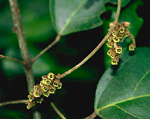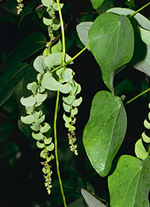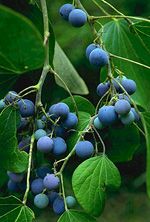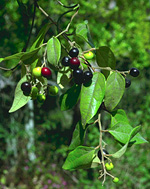 |
Species in this family occur throughout the tropical regions of the world. In Australia also they are essentially tropical, mostly in rainforests from the Kimberley region of Western Australia, across the Top End of the Northern Territory and along the eastern coast as far south as far eastern Victoria. A few species occur on tropical strandlines.
Characteristic features of the family Menispermaceae in Australia include: - woody climbers or creepers with large, often glabrous and glossy, rounded leaves, usually palmately veined, long-petioled, and sometimes with the petiole attached to the face of the blade (peltate)
- flowers small, unisexual, often greenish-white, in racemes or umbels
borne in leaf axils or on old wood, with 3 perianth parts or 3 sepals
and 3 petals, all the parts free
- male flowers with few to many stamens, sometimes fused into bundles; female flowers with few to many free carpels
- fruits black or red, fleshy drupes, often with remnants of the stigma visible in a line down one side
- fruit a large, aromatic, edible berry with numerous black seeds
Description
Woody or perennial herbaceous vines climbing by twining or scrambling stems or by ?twining petioles, rarely evergreen shrubs. Perennating by tubers or rhizomes. Internal secretions not obvious. Plants glabrous, or with simple or dendritic, non-glandular hairs. Leaves alternate and spiral; petiolate or peltate; pulvinae present or absent. Stipules absent. Lamina simple, symmetric, filiform, acicular, subulate, linear, lanceolate, ovate, elliptic, oblanceolate, ovate, oblong or orbicular; base cuneate, rounded, cordate, hastate or sagittate, reniform or lobed or auriculate; margins entire or sinuate, ±flat; venation pinnate, or palmate, or rarely one-veined, with the midrib conspicuous, and the tertiary venation reticulate or not; surfaces not punctate; herbaceous, leathery, membranous or papery. Male and female flowers occurring on separate plants. Inflorescences terminal or axillary, consisting of spikes, racemes, panicles, cymes, thyrses or umbels. Bracts present or absent. Bracteoles ?present or absent. Pollination by insects. Flowers odourless or fragrant, sessile or stalked. Floral disc absent; nectaries absent or present on the perianth. Perianth regular, of 2 dissimilar whorls. Calyx segments free, with (1 or) 3–4 sepals, herbaceous. Corolla free or fused, with (1 or) 3–4 petals or lobes, alternating with or opposite the sepals, imbricate, valvate or open in bud; corolla cup-shaped, white, cream, yellow, orange or green, without contrasting markings, membranous or succulent; claws present or absent; lobes ±entire. Fertile stamens 3–4, 6, 9 (–40), opposite to and/or alternating with, or not clearly correlated with, the sepals, free of the corolla, free of the ovary and style, distinct from each other, or fused by their filaments into an open or closed tube, or fused by their anthers, all ±equal. Anthers dorsifixed or basifixed, not versatile, opening outwards, sideways or inwards by longitudinal slits or by transverse slits, 2-celled. Ovary superior and sessile. Carpels 1–32, free from each other. Style terminal, single and unbranched. Ovules 2 per carpel, ?stalked; placentation axile or marginal. Fruit a fleshy, indehiscent drupe, rarely of fused drupelets (drupetum); the perianth on the maturing fruit deciduous. Disseminule macro-surface featureless or with straight hairs; micro-surface ±smooth, cream, yellow, orange, red, magenta, purple, violet, blue or black, glossy or dull. Seeds 1 per fruit. Aril absent. Cotyledons 2. Embryo straight, curved or sharply bent.
(Note: this description has been generated from the coded data compiled for the key. Any errors in the key data will be reflected in the descriptions.)ONT>
A treatment of the family Menispermaceae has not yet been published in the Flora of Australia. It will appear in Volume 2.
Australian genera of Menispermaceae (as recognised for the Flora of Australia)
Carronia
Hypserpa
Legnephora
Pachygone
Pleogyne
Pycnarrhena
Sarcopetalum
Stephania
Tiliacora
Tinospora

|
  |

Carronia multisepala (female flowers)
Photo: D.Jones © D.Jones

Cissampelos pareira (flowers)
Photo: D.Jones © D.Jones

Legnephora moorei (fruits)
Photo: G.Leiper © G.Leiper

Pleogyne australis (fruits)
Photo: G.Leiper © G.Leiper

|
 |
|